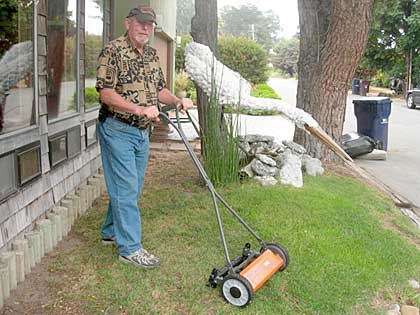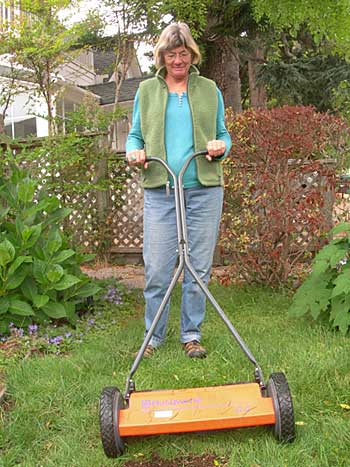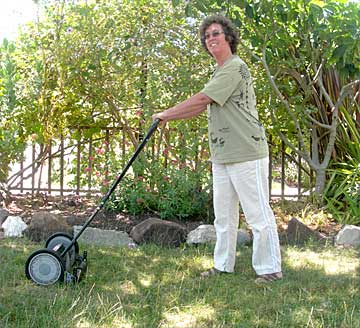Cutting their carbon footprints
January 2009

Jerry Clarke mows next to the sculpture he created from driftwood and shells. Photo by Debbie Bulger.
by Debbie Bulger
A growing number of Central Coast residents have found a cleaner and greener way to cut their lawns. They are cutting their carbon footprints along with their grass. Esther Trible, Jerry Clarke, Karen Warren, Roberta Friedman, Robin Drury, and Andrew Dyer are a few of the smart locals using push mowers.
While friends and relatives in the Northeastern and Midwestern parts of the United States are shoveling snow or complaining about the cold, we on the Central Coast are mowing our lawns. If we use gasoline-powered lawnmowers, we are also emitting noise and noxious fumes.
An old two-stroke lawnmower can generate as much pollution in one hour as 40 pre-1995 cars driven for the same amount of time according to the Sacramento Metropolitan Air Quality Management District. A 2001 study by a Swedish chemist found that an average 4-stroke, 4-horsepower lawnmower used for one hour emitted the same pollution as a typical modern car driven about 100 miles. The researcher, Roger Westerholm, recommended putting catalytic converters on lawnmowers.
After a long fight with the U.S. EPA, California won the right to do just that. Starting in 2007 the California Air Resources Board required catalytic converters for lawn-mowers sold in California. In 2008, EPA finally adopted similar requirements for the nation which will begin in 2011.
Capitola resident Esther Trible enjoys the light weight of her push lawnmower, a Husqvarna. Her neighbor, Jerry Clarke, liked Trible’s lawnmower so much, he borrowed it for 10 years. It was quieter and more maneuverable than his gas mower. Now Jerry has his own. Esther bought it for him as a thank you gift for Jerry’s work in rebuilding her back deck.

Capitola resident Esther Trible enjoys the light weight of her push mower. Photo by Debbie Bulger.
Both Trible and Clarke have small lawns. Trible’s keeps getting smaller. Last year she ripped out 200 square feet of lawn and replaced it with native and drought-tolerant plants. The Soquel Creek Water District paid her $2/sq. ft. for the conversion—enough to pay for the plants which are watered by drip irrigation.
“I have 10–15 varieties of salvia. Now there are many more birds and bees in my yard,” Trible said.
Even if you’re not interested in learning about the birds and the bees, you might want to learn about the benefits of push mowers. Push mowers, also called reel mowers or manual mowers, use human energy instead of fossil fuels. They provide good exercise, are quiet, economical, and best of all, use no gasoline or oil.
Karen Warren of Santa Cruz grew up using a push mower. She has a larger front and back lawn than either Trible or Clarke. Warren’s young daughter uses the yard to play, and her parents enjoy neighborhood get-togethers outside. “I hate the noise of a gas mower,” Warren explains. “When you’re spending time outside, you don’t want it spoiled by the noise of a gas mower.”
Roberta Friedman chose a push mower when the sound of the electric one she had been using made her toddler cry. “Besides,” she says, “I kept running over the cord.”
A quick Google search of “reel mowers” will give you a variety of options and brands to consider.

Karen Warren of Santa Cruz grew up using a push mower. Photo by Debbie Bulger.
< back to all issues

